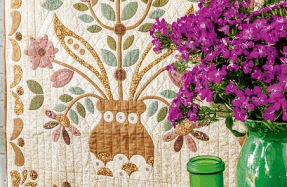
Proudly brought to you by


Stitch along with us on our special Facebook group
Homespun Block of the Month 2023 Owl & Hare Hollow

Finished size: 194 × 159cm (76½ × 62½in)
Stitches used: Backstitch, cross stitch, detached chain (lazy daisy) stitch, French knot, running stitch, satin stitch, straight stitch
Note: Materials required for the entire project were listed in Part 1, published in Homespun 24.1 (February/ March 2023 issue). They are from the Owl & Hare Hollow, Blume and Grow and Birdhouse Basics ranges designed by Natalie herself. Requirements are based on fabric 107cm (42in) wide, except for the backing fabric, which is 147cm (58in) wide and the Devonstone cream cotton/linen blend fabric, which is 137cm (54in) wide. To make your quilt unique and to achieve a scrappy look, select fabrics from your assorted prints at random to sew each block. Use the photos of Natalie’s quilt as a guide or just pick and choose as you like. The appliqué method used is needleturn, but you can adapt the instructions to your preferred method. Seam allowances of ¼in are used throughout for the piecing. Two strands of embroidery thread are used throughout, unless otherwise stated. Instructions are given




